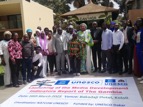
The report, which is the first-ever in the country, looked at media development in The Gambia since the change of government in 2017.
In essence, the report which is grouped into five categories, gives a broader idea of the Gambian media landscape and level of progress recorded in terms of development, as well as the numerous challenges and existing gaps, which are factors impeding media independence and pluralism.
At the launch, Modou S. Joof, secretary general of the Gambia Press Union (GPU), said GPU, its affiliates, and members participated in the Assessment of Media Development in The Gambia since the task started, and today, “we are happy to be associated with the launch of this report”.
“At the Gambia Press Union, we have followed with keen interest the development of the media sector in terms of improved press freedom, a proliferation of media houses, and improved professional development.”
SG Joof disclosed that in the recent past, the country has seen an increase in the number of private radio stations by almost 75%, with 39 FM stations in operations as of 2021, according to data from the Public Utilities Regulatory Authority (PURA), which is responsible for registration of broadcast media.
“Gambians now enjoy the luxury of watching multiple local television channels, with five private television stations in operations, in addition to the national television which was the only TV station until 2017 when television broadcasting services was liberalised,” he noted.
He pointed out that there are seven newspapers, with five regularly publishing a print version, and nine community radio stations, and at least twenty online news media platforms.
This, he added, means that more people now have access to the media to express their opinions on issues concerning their lives and livelihoods, and on issues of government and governance.
Presenting the report, Elvis Michel, from UNESCO-Dakar regional office, disclosed that the report is based on UNESCO’s Media Development Indicators, adding that these MDIs, approved in 2008 by the 26th session of the Intergovernmental Council of the International Programme for the Development of Communication (IPDC), provide a comprehensive framework for the assessment of national media landscapes and have been applied in a number of countries all over the world.
He noted that they are complemented by other UNESCO indicators systems that enable national assessments of the wider Internet environment of communications, issues of media and gender equality, the safety of journalists, and media’s economic viability.
The Media Development Indicators, he added, is grouped into five categories and each chapter of the report deals with one of these categories.
“The first chapter analyses the legal, regulatory and policy framework for the media in The Gambia as well as laws and other possible restrictions on media freedom and freedom of expression in general,” he explained.
“The Gambian Constitution of 1997 guarantees freedom of speech and expression, including freedom and independence of the media. It also provides for limitations of these rights in the interest of national security, public order or morality.
“A newly drafted constitution was rejected in parliament in 2020. Among others, it was designed to set very stringent conditions on such limitations.”
He recalled that in August 2021, an Access to Information Act was signed into law by the President, adding that the Act provides the right to access public records and information held by public authorities and certain private institutions.
“At the time of writing, the Act still needs to be fully implemented and contravening legislative provisions, such as parts of the Official Secrets Act, have not yet been revised or scrapped,” he stated.
Launching the report, Lamin Quin Jammeh, minister of Information and communication Infrastructure, first thanked UNESCO/NATCOM and all their partners for their collaboration, saying their support has paid dividend as witnessed in the launch of the Gambia media development indicators report.
“Appreciating the media as the Fourth Estate in any state and the critical role that it performs in a democracy, media development indicators report launching in every context, can only be seen as a welcoming development. An important justification for this can be seen as the Barrow administration has committed itself to the democratization of state and public life in The Gambia since it assumed political authority in 2017,” he said.
Minister Jammeh said that evidence of this assertion is the enactment of the Access To Information Act (ATI), which abundantly manifests the availability of the requisite political will as the basis for future development in the media sector in particular and the information value chain in general.
He said further: “It may be gratifying to note that as far as the Government of The Gambia is concerned, there is no turning back building on the democratic credentials of the government and manageable velocity, enhanced by time, space and the much-needed resources shall continue to be the pre-occupation of government through my Ministry and her development partners and stakeholders.”
He also reiterated government’s unwavering commitment necessary for the achievement of goals in the country’s media sector.
However, the report, which also made some recommendations, was presented to Minister Jammeh for onward actions by government.
Speakers on the occasion included Lamin Jarju, senior programme officer at NATCOM.





